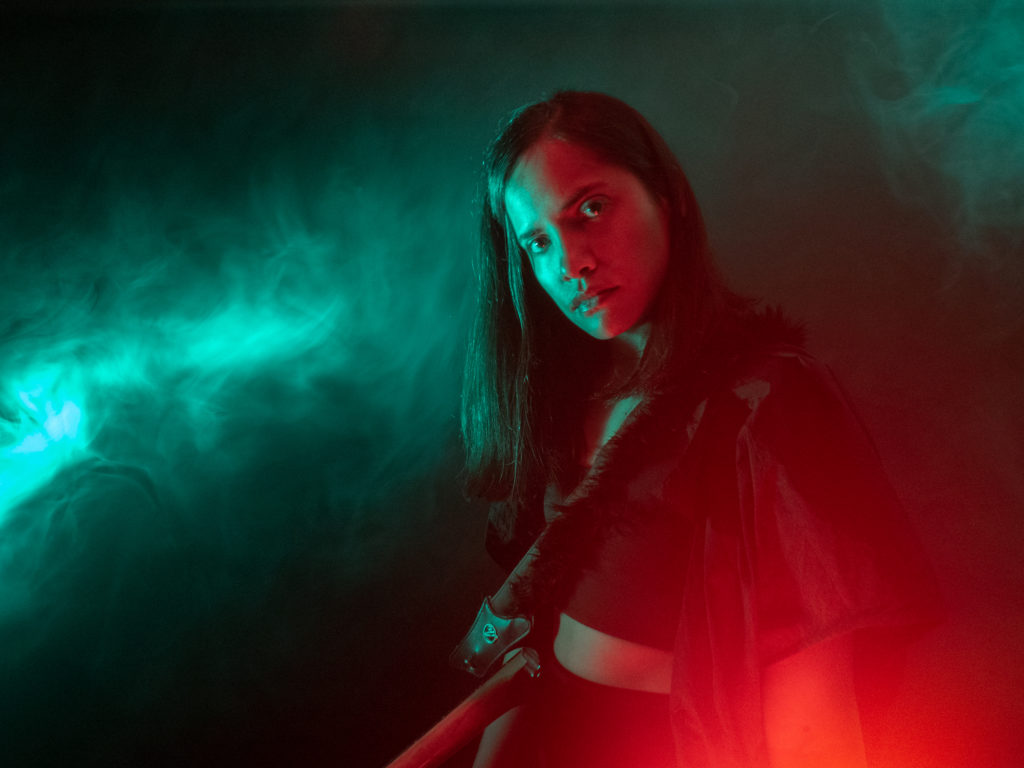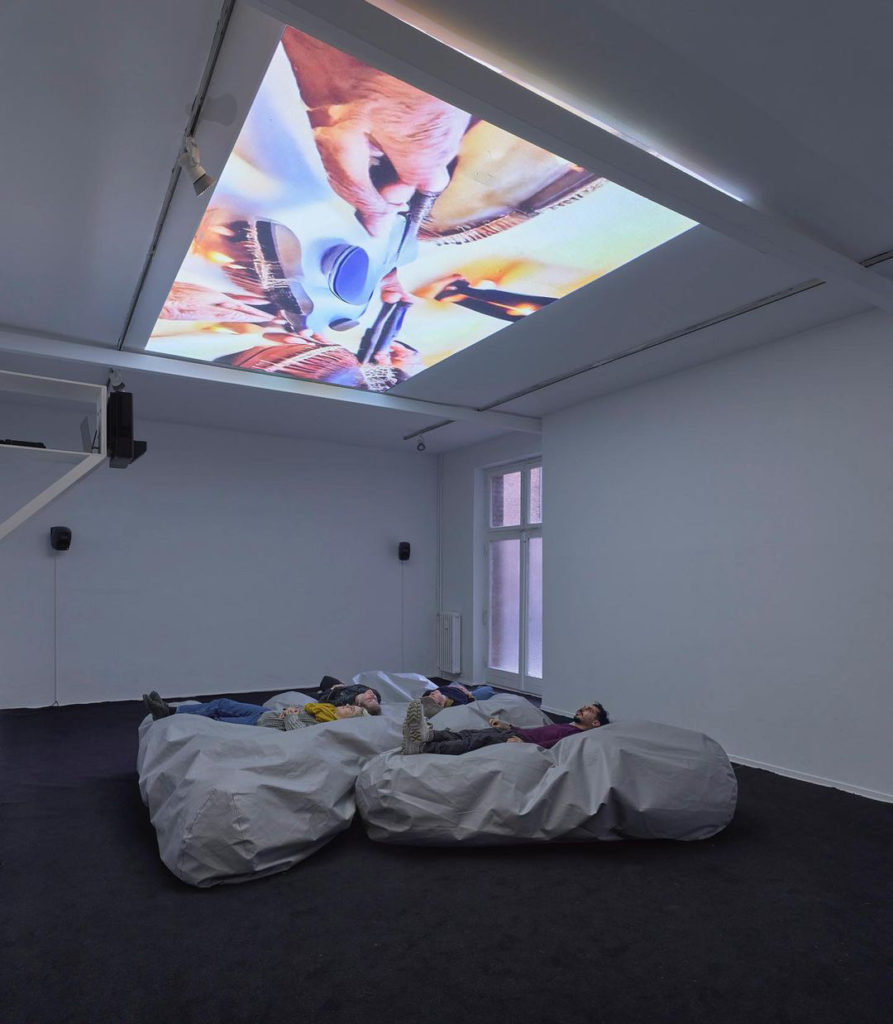Alejandra Cárdenas Pacheco (also known as Ale Hop) is a Peruvian-born artist, researcher, and experimental musician based in Berlin. Her body of work includes live shows, record releases, sound and video artworks, research on sound and technology, and original music for film, dance and theatre projects.
You began your career in the 2000s, in Lima’s experimental and underground scene. Can you recollect this period and environment? How did you enter this scene, and how important was it for your future development?
The year 2000 was a meaningful year for me. Before that, at the end of the 90s, I was obsessed with music, but it was more focused on collecting, recording cassettes, buying CDs, tabs and scores, and so on. It was the last period of Alberto Fujimori’s dictatorship, and I went to a middle-class high school where kids were mainly pro-Fujimori (because their parents were). He was demolishing every democratic institution left in the country, while on TV and radio, tecnocumbia music was the sensation of the time. Later, it became known that musicians, TV hosts and leading people in the media received dirty money from the dictator’s regime.
But coming back to the year 2000, it was the first time I attended an underground “rock” concert (rock in quotes because it brought together many genres), and it was the first time I saw three hundred angry people shouting against the government. My first thought was, “this is where I want to stand.” I then lost interest in grunge, pop, or anything happening on MTV. For the next decade, I was involved in bands. I tried different styles, from punk to garage and pop, and finally landed in electronic and experimental music, which was a very small and marginal scene in the city then but has grown exponentially in the last decade. On the other hand, this underground “rock” became more popular and depoliticised quickly and was monotonous and quite uninteresting. However, it was not the political aspect that attracted me in the first place; it was always more about the reality depicted in contrast with what the mass media was showing.
There was something about growing up in the 1990s-2000s in Lima, an environment that was violent and repressive, that stays with you. I think, nowadays, my live show sometimes becomes an outburst of this mental state, which is like a trauma finding its way out. I realised some time ago that this happened naturally if I played my instrument from a position of vulnerability in relation to the audience. That is why I avoid postures or gestures that appear powerful when playing the electric guitar, which is my main instrument on stage. Even though I work in different formats (releases, video, installation, research), I would say that the live show is the centre of everything I do because it is the only practice in which I can experience this.
In Berlin, you direct a platform called Contingent Sound, which aims to facilitate critical thought, artistic research, and experimental formats relating to the practice of listening and relationality focusing on the global South. Can you talk about this platform and your role in it?
I put together a publication in 2020 under the title Border-Listening/Escucha-Liminal, which gathered texts from Latin American theoreticians working in the field of sound. The idea was to make it the companion of the discursive programme of the Radical Sounds Latin America festival, which I was co-curating back then, and it became a hybrid event that year because of the COVID crisis.
What I was really looking to do was to compile an entire book of Latin American positions on listening. Also, to find meeting points in their concepts and methodologies. For example, I knew that many of them were articulating categories of analysis related to the Latin American “modernity/coloniality” group. And these are decolonial perspectives that are different from postcolonial studies. The latter has had a more significant influence on sound studies over the last years.
I edited a second edition in 2021, but then I left the festival team because it was too time-consuming. Thus, I founded the Contingent Sounds platform to continue with this editorial work. We now have three books in the making for next year that are very exciting.
You have been mapping the music scenes of Latin America, for instance, you made a beautiful mixtape focused on female pioneers of electronic and electroacoustic music. The focus has largely been on Western composers in this field, and awareness of non-Western early electroacoustic and experimental music remains minimal. Can you talk about your research in this field?
This also relates to one of the book projects we’ll be releasing next year with Contingent Sounds; I can’t say much about it before it is announced. However, I made this mixtape as I was diving into the subject, also for my personal artistic research. I thought it was a shame I didn’t know about these fantastic composers until a few years ago.
Another project rooted in South America is your audiovisual installation “Why Is It They Say a City Like Any City?” It imagines a hallucinatory journey through South American territories, through sound and visual vignettes created in collaboration with thirteen musicians around the world. Can you talk about this project in particular?
Yes, this project was my 2020 COVID-lockdown baby. It began as an exercise of telepathy. I wanted to do a collaborative project with musicians I admire who live in different parts of the world, and I refused to use Zoom or any of those videoconference technologies. I was doing this exercise back then: writing postcard-like messages or letters from places I wanted to go to. They were all located in South America. I used several sources to write them: memories, history books, and weird YouTube videos of people walking through the streets of those cities. I found them fascinating (now, you can find these YouTube videos of people walking in almost every city in the world). It occurred to me that instead of sending an instrument line to the musicians I wanted to collaborate with, I could use these letters, and send them a “place” and ask for responses in the form of sounds. So, I had six cities and thirteen musicians.
I then asked myself what would happen if I sent the same message (describing a city) to two or three musicians in different parts of the world, and then put their sound responses together as one sound piece. I wondered if it were possible that their sound responses would tell me something about this place, and that by putting them together, something else could resonate. So, this is how I begin to articulate these “vignettes” of the cities.
For the installation version of the piece, I put my voice back with the original messages, between vignette and vignette, because I thought it was necessary to show the originator of this process. And finally, I wanted to have a visual part, so my colleague Moises Horta, an AI artist, suggested that these messages could be interpreted through an Artificial Intelligence tool that synthesises images from words. I thought this last step could be interesting since these tools have been trained to identify and symbolically correlate words to text from people’s data behaviour. So, he was the last collaborator to come on board. Also, aesthetically, the video he generated looks like cutting into a brain and looking into someone’s thoughts.
You are a sound artist and a researcher at the same time, a practicing sound artist as well as someone who reflects upon various occurrences in experimental music and practice from a theoretical point of view. How do these two practices of yours influence each other in your work?
It has taken me a long to figure that one out. I feel as if I was always a musician. There is an old photo of me trying to play the piano at age four. And I don’t remember a time when I wasn’t obsessed with making sounds with instruments. But then, after high school, society’s influence made me think that playing weird music would never be a real source of income, so I went to university and studied art history, which I really enjoyed, with the idea of specialising in musicology.
But then—jump to the future—, in 2015, the shocking evidence pointed to the opposite: that academic life had become, in fact, the hobby, whereas making music had become the main act paying the bills—the joke is on society. So, I had to reassess my priorities. I had just moved to Berlin and decided that as part of this realisation, I was going to do a master’s in arts that was practice-oriented.
After the past few years of struggling with switching “primary” practice back and forth, I found a way to combine them more intelligently. I try to find commonalities and make them inform each other. Now it has become more fluid. I especially appreciate everything that lies in between.
Your lecture at CTM entitled “Action-based Sound and Cognitive Capitalism” talked, among other things, about the ways in which digital interfaces change our perception. How do you view the interplay between digital technologies, perception and sound as well as the future development of this interaction?
I do believe that new technologies alter the user’s attention circuits and subjectivity in ways that we have not yet realised. But that lecture was more like a short provocation on an idea I had that took off from Murray Schafer’s seminal book The Soundscape. He described the importance of the church bell as the sound that defined every medieval European city. Because the bell created an acoustic space in the centre of the city. The range of the church bell (where this sound could be heard) circumscribed the city. And in a way, also its religious dimension, signalling the divine Christian calendar.
I wanted to make a parallel with something Byung-Chul Han wrote about the smartphone being the devotional object of our era. If in the medieval age, we have this deafening metallic sound bell resonating from the centre of the feudal city, the very nucleus of society and belief back then. In present times, when European cities are disconnected from their production reality, smartphones produce short, discreet, user-friendly alarms that resonate in immaterial networks.
What are your current projects?
My current projects are:
- To continue touring my live show. Coming up next – Timisoara, Budapest, Den Bosch, Switzerland, and more TBC.
- A new solo album that is in the making, very guitar-oriented,
- The new project I just formed with the Peruvian Cajón player and percussionist Laura Robles, where we disarticulate and manipulate traditional Peruvian rhythms, accompanied by the dancer Liza Alpízar Aguilar. It just premiered at the Heroines of Sound festival.
- In September, I’m again presenting the piece ‘Why Is It They Say a City Like Any City?’ at Silent Green in Berlin.
Interview by Lucia Udvardyova

